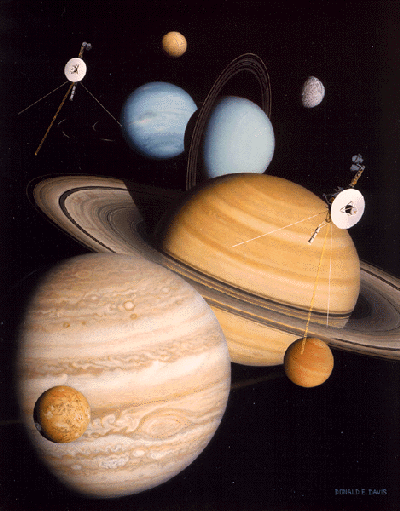


 Français
Français
Encyclopedia > Numbers about the solar system XXI
THE LARGEST BODIES OF THE SOLAR SYSTEM

The measurements made in situ by the space probes allowed us to know precisely the size and form of many solar system bodies.
Until the XXth century, the measurements of the diameters of the largest solar system bodies have been made thanks to visual micrometers. In the some cases, the observation of occultations allowed to get a precise value.
This table provides the equatorial diameters for the largest bodies (sorted by minimal apparent diameters). The distance to the Earth makes that the apparent size is quite different than the real size. In this table, the two other columns provide the minimal and maximal values of the apparent diameter (in arcsec).
Click on the head of the column to sort by the different parameters.
| Name | Diameter
(km) |
Diameter
angular minimal (") |
Diameter
angular maximal (") |
| Sun | 1 392 000 | 1890 (31'.5) | 1950 (32'.5) |
| Moon | 3 475 | 1758 (29'.3) | 2010 (33'.5) |
| Jupiter | 142 984 | 30.5 | 49.5 |
| Saturn | 120 536 | 15.0 | 20.5 |
| Venus | 12 104 | 9.6 | 66.0 |
| Mercury | 4 879 | 4.6 | 12.9 |
| Mars | 6 794 | 3.5 | 26.0 |
| Uranus | 51 118 | 3.3 | 4.3 |
| Neptune | 49 528 | 2.4 | 2.9 |
| Ganymedede (J3) | 5 268 | 1.1 | 1.8 |
| Callisto (J4) | 4 806 | 1.0 | 1.7 |
| Io (J1) | 3 660 | 0.8 | 1.3 |
| Europa (J2) | 3 130 | 0.7 | 1.1 |
| Titan (S6) | 5150 | 0.6 | 0.9 |
| (1) Ceres | 934 | 0.32 | 0.84 |
| (4) Vesta | 510 | 0.20 | 0.62 |
| Rhea (S5) | 1 528 | 0.19 | 0.26 |
| Iapetus (S8) | 1 436 | 0.18 | 0.24 |
| (2) Pallas | 526 | 0.16 | 0.63 |
| Dione (S4) | 1 120 | 0.14 | 0.19 |
| Triton (N1) | 2 705 | 0.13 | 0.16 |
| Tethys (S3) | 1 060 | 0.13 | 0.18 |
| Titania (U3) | 1 578 | 0.10 | 0.13 |
| Oberon (U4) | 1 523 | 0.10 | 0.13 |
| Umbriel (U2) | 1 169 | 0.08 | 0.10 |
| Ariel (U1) | 1 162 | 0.08 | 0.10 |
| Pluto | 2 390 | 0.07 | 0.11 |
| Enceladus (S2) | 513 | 0.06 | 0.09 |
| Charon (P1) | 1 186 | 0.03 | 0.05 |
| Earth | 12 756 | - | - |



